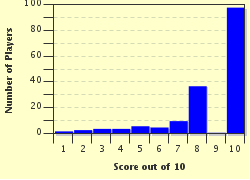Quiz Answer Key and Fun Facts
1. Capet--Flight to Varennes--Ancien Régime
2. Jacobin Club--Committee of Public Safety--Reign of Terror
3. Enlightenment--Philosophe--Separation of Powers
4. Girondist--Jean-Paul Marat--Guillotine
5. Austrian--Petit Trianon--Affair of the Diamond Necklace
6. Neoclassicism--National Convention--Napoleon Bonaparte
7. Roman Catholic "abbé" (priest)--"What is the Third Estate?"--Directory
8. Jean-Marie Roland de la Platière--Salon--Girondist
9. American Revolution--Declaration of the Rights of Man--National Guard
10. Swiss Banker--Director-General of Finance--"Compte rendu au roi"
Source: Author
ponycargirl
This quiz was reviewed by FunTrivia editor
bloomsby before going online.
Any errors found in FunTrivia content are routinely corrected through our feedback system.

